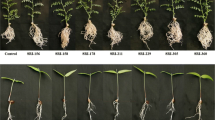Summary
The use of trap crops such as cowpea could reduce the effects of the root parasitic weed, Striga hermonthica and its subsequent constraints on the growth of cereals. Certain bacteria could augment the trap crop stimulatory effect. We studied the effect of three bacteria introduced to the rhizosphere of three cowpea varieties at planting. Number of days to cowpea flowering was noted and at harvest, data were collected on pod characteristics and biomass. Means of data subjected to ANOVA were compared using Tukey’s Studentized Range Test. We analysed bacterial headspace volatiles for ethylene by gas chromatography and gas chromatography–mass spectrometry. Bacterial type significantly influenced the cowpea varieties with better performance over the non-inoculated control. Average pod weight (g) with bacterial treatment was 37.97 for Enterobacter sakazakii 8MR5, 34.38 for Pseudomonas 44MS8 and 27.46 for Pseudomonas 10M3. Non-inoculated control had an average weight of 20.98 g. Bacteria promoted a significant increase in pod weight (≥30.89%), fresh biomass (≥24.22%), and improved pod number (≥20.54%) and pod wall thickness (≥7.33%) with no deleterious effect on plant health. Ethylene released by the bacteria ranged from trace concentrations in Pseudomonas sp. to 210 nmoles/108 c. f. u./ml in Ent. sakazakii 8MR5.
Similar content being viewed by others
References
Ahonsi MO, Berner DK, Emechebe AM, Lagoke ST (2002) Selection of rhizobacterial strains for suppression of germination of Striga hermonthica (Del.) Benth. Seeds. Biol Control 24:143–152
API20E (1988) Identification system for Enterobacteriaceae and other Gram-negative rods. Instruction manual, Version D. No. 2010
Babalola OO, Osir EO, Sanni AI (2002) Characterization of potential ethylene-producing rhizosphere bacteria of Striga-infested maize and sorghum. Afr J Biotechnol 1:67–69
Babalola OO, Osir EO, Sanni AI, Odhiambo GD, Bulimo WD (2003) Amplification of 1-amino-cyclopropane-1-carboxylic (ACC) deaminase from plant growth promoting bacteria in Striga-infested soil. Afr J Biotechnol 2:157–160
Babalola OO, Berner DK, Sanni AI (2004a) Effect of plant pathogenic Pseudomonas strains and their method of application on Striga hermonthica-infested maize and sorghum. Section 3, Bio-control. Advances in plant protection strategies and technology. In: 15th International Plant Protection Congress (IPPC 2004) 11–16 May 2004, Beijing, China
Babalola OO, Sanni AI, Odhiambo GD (2004b) Isolation of rhizobacteria associated with maize and assessment of their potential for use in Striga hermonthica (Del.) Benth. suicidal germination. J Trop Microbiol 3:64–70
Bebawi FF, Eplee RE, Norris RS (1984) Longevity of witchweed (Striga asiatica) seed. Weed Sci 32:494–497
Berner DK, Schaad NW, Volksch B (1999) Use of ethylene-producing bacteria for stimulation of Striga spp. seed germination. Biol Control 15:274–282
Burr TJ, Schroth MN, Suslow T (1978) Increased potato yields by treatments of seed pieces with specific strains of Pseudomonas fluorescens and P. putida. Phytopathology 68:1377–1383
Eplee RE, Norris RS (1987) Field research techniques. CRC Press Inc., Boca Raton
Gbehounou G, Adango E (2003) Trap crops of Striga hermonthica: in vitro identification and effectiveness in situ. Crop Prot 22:395–404
Herb R, Visser JH, Schildknecht H (1987) Recovery, isolation and preliminary structural investigation of germination stimulants produced by Vigna unguiculata walp. cv Saunders upright. In: Proceedings of the fourth international symposium on parasitic flowering plants, Phillips University, Marburg, pp 202–210
Howie WJ, Echandi E (1983) Rhizobacteria: Influence of cultivar and soil type on plant growth and yield of potato. Science 4:86
King EO, Ward MK, Raney DE (1954) Two simple media for the demonstration of pyocyanin and florescin. J Lab Med 44:301–307
Kiriro HF (1998) The Striga problem in Kenya. In: Kim SK (ed) Proceeding of the International Workshop organized by IITA, ICRISAT and IDRC, IITA, Ibadan, pp 15–17
Klyuchnikov AA, Kozhevin PA (1991) Dynamics of Pseudomonas fluorescens and Azospirillum brasilense populations during the formation of the vesicular arbuscular mycorrhiza. Microbiology 59:449–452
Lambot C (2000) Industrial potential of cowpea. In: World cowpea research conference 111. 4–7 September 2000. Abstracts of paper and poster presentations IITA, IITA, Ibadan, pp 31
NIST (1995) NIST registry of mass spectral data. Wiley, England
Odhiambo GD (1998) Studies on witchweed (Striga hermonthica (DEL.) BENTH) seed longevity and maize (zea mays) productivity under different management systems in Kenya. PhD. Thesis, University of Reading
Ransom JK (1997) An update on Striga control research in Western Kenya. In: Advances in Striga Research in Kenya. In: Proceedings of a workshop held in Kisumu 4–5 December 1995 KARI, KARI, Kisumu, pp 4–11
Ransom JK (2000) Long-term approaches for the control of Striga in cereals: field management options. Crop Prot 19:759–763
SAS (1998) SAS/STAT Users’ Guide, 4th edn SAS Institute Incorporation., version 6, SAS Users guide: statistics, Cary
Sato M, Urushizaki S, Nishiyama K, Sakai F, Ota Y (1987) Efficient production of ethylene by Pseudomonas syringae pv. Glycinea which causes Halo Blight in soyabeans. Agri Biol Chem 51:1177–1178
Sugimoto Y, Ali AM, Yabuta S, Kinoshita H, Inanaga S, Itai A (2003) Germination strategy of Striga hermonthica involves regulation of ethylene biosynthesis. Physiol Plant 119:137–145
Acknowledgements
We are grateful to Dr Peter Njagi, and Mr Manyama Onesmas for active technical help and Dr A. Odulaja for statistical analysis. We also acknowledge the assistance of KARI-CIMMYT Striga project for pure ethylene gas. Third World Organization for Women in Science supported this research.
Author information
Authors and Affiliations
Corresponding author
Rights and permissions
About this article
Cite this article
Babalola, O.O., Sanni, A.I., Odhiambo, G.D. et al. Plant growth-promoting rhizobacteria do not pose any deleterious effect on cowpea and detectable amounts of ethylene are produced. World J Microbiol Biotechnol 23, 747–752 (2007). https://doi.org/10.1007/s11274-006-9290-6
Received:
Accepted:
Published:
Issue Date:
DOI: https://doi.org/10.1007/s11274-006-9290-6




